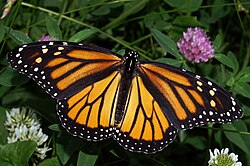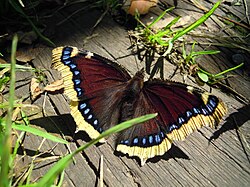Wildlife Gardening/Location/West Virginia/Rhopalocera
| Native butterflies of West Virginia | |||||||
|---|---|---|---|---|---|---|---|
| Taxon | Amphibians and fishes | Birds | Mammals | Reptiles | Invertebrates | Plants and fungi | Notes |
 |
|
|
|
|
|
|
|
 |
|
|
|
|
|
|
|
 |
|
|
|
|
|
|
|
 |
|
|
|
|
|
|
|
 |
|
|
|
|
|
|
|
 |
|
|
|
|
|
|
|
 |
|
|
|
|
|
|
|
 |
|
|
|
|
|
|
Beautiful orange butterfly filled with chemicals most birds find foul tasting or poisonous. Although dependent on milkweed as the sole host for its caterpillars, it will pollinate a large variety of flowering plants as an adult. Monarch numbers have declined in recent years, attracting widespread attention from backyard conservationists. It is also West Virginia's official state butterfly. |
 |
|
|
|
|
|
|
|
 |
|
|
|
|
|
|
|
 |
|
|
|
|
|
|
|
 |
|
|
|
|
|
|
|
 |
|
|
|
|
|
|
|
 |
|
|
|
|
|
|
Two subspecies inhabit the state. The most common is L. a. astyanax, which is a striking dark blue color, imitating the poisonous pipevine swallowtail despite being harmless itself. The second is L. a. arthemis, found in the eastern part of the state, which is darker and bears a prominent white band across the wings. Unlike most butterflies, adults prefer rotting fruit, tree sap, and dung to nectar, making this species a visually striking but substandard pollinator. |
 |
|
|
|
|
|
|
|
 |
|
|
|
|
|
|
|
 |
|
|
|
|
|
|
|
 |
|
|
|
|
|
|
|
 |
|
|
|
|
|
|
|
 |
|
|
|
|
|
|
|
 |
|
|
|
|
|
|
|
 |
|
|
|
|
|
|
|
 |
|
|
|
|
|
|
|
 |
|
|
|
|
|
|
|
 |
|
|
|
|
|
|
|
 |
|
|
|
|
|
|
|
 |
|
|
|
|
|
|
|
 |
|
|
|
|
|
|
|
 |
|
|
|
|
|
|
|
 |
|
|
|
|
|
|
|
 |
|
|
|
|
|
|
|
 |
|
|
|
|
|
|
|
 |
|
|
|
|
|
|
|
 |
|
|
|
|
|
|
|
 |
|
|
|
|
|
|
Beautiful orange butterfly. |
 |
|
|
|
|
|
|
|
| Native butterflies of West Virginia | |||||||
|---|---|---|---|---|---|---|---|
| Taxon | Amphibians and fishes | Birds | Mammals | Reptiles | Invertebrates | Plants and fungi | Notes |
 |
|
|
|
|
|
|
|
